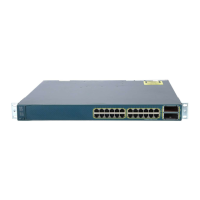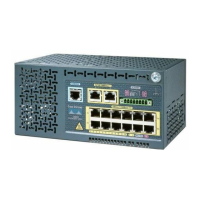13-19
Catalyst 3750 Switch Software Configuration Guide
78-16180-02
Chapter 13 Configuring VLANs
Configuring VLAN Trunks
802.1Q Configuration Considerations
802.1Q trunks impose these limitations on the trunking strategy for a network:
• In a network of Cisco switches connected through 802.1Q trunks, the switches maintain one instance
of spanning tree for each VLAN allowed on the trunks. Non-Cisco devices might support one
spanning-tree instance for all VLANs.
When you connect a Cisco switch to a non-Cisco device through an 802.1Q trunk, the Cisco switch
combines the spanning-tree instance of the VLAN of the trunk with the spanning-tree instance of
the non-Cisco 802.1Q switch. However, spanning-tree information for each VLAN is maintained by
Cisco switches separated by a cloud of non-Cisco 802.1Q switches. The non-Cisco 802.1Q cloud
separating the Cisco switches is treated as a single trunk link between the switches.
• Make sure the native VLAN for an 802.1Q trunk is the same on both ends of the trunk link. If the
native VLAN on one end of the trunk is different from the native VLAN on the other end,
spanning-tree loops might result.
• Disabling spanning tree on the native VLAN of an 802.1Q trunk without disabling spanning tree on
every VLAN in the network can potentially cause spanning-tree loops. We recommend that you
leave spanning tree enabled on the native VLAN of an 802.1Q trunk or disable spanning tree on
every VLAN in the network. Make sure your network is loop-free before disabling spanning tree.
Default Layer 2 Ethernet Interface VLAN Configuration
Table 13-6 shows the default Layer 2 Ethernet interface VLAN configuration.
Configuring an Ethernet Interface as a Trunk Port
Because trunk ports send and receive VTP advertisements, to use VTP you must ensure that at least one
trunk port is configured on the switch and that this trunk port is connected to the trunk port of a second
switch. Otherwise, the switch cannot receive any VTP advertisements.
This section includes these procedures for configuring an Ethernet interface as a trunk port on the switch:
• Interaction with Other Features, page 13-20
• Defining the Allowed VLANs on a Trunk, page 13-21
• Changing the Pruning-Eligible List, page 13-22
• Configuring the Native VLAN for Untagged Traffic, page 13-23
Table 13-6 Default Layer 2 Ethernet Interface VLAN Configuration
Feature Default Setting
Interface mode switchport mode dynamic auto
Trunk encapsulation switchport trunk encapsulation negotiate
Allowed VLAN range VLANs 1 to 4094
VLAN range eligible for pruning VLANs 2 to 1001
Default VLAN (for access ports) VLAN 1
Native VLAN (for 802.1Q trunks) VLAN 1
